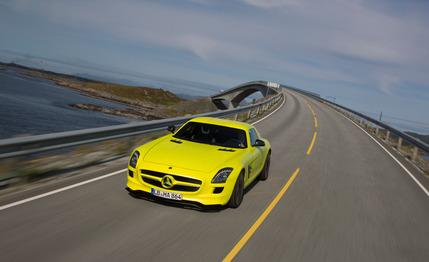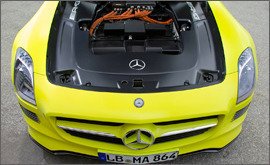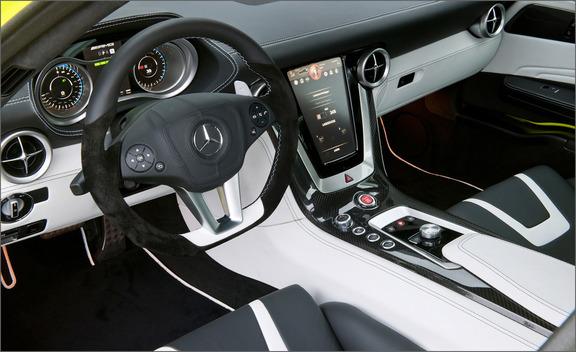
 Prototype Drive
Prototype Drive
We remain somewhat skeptical of electric cars, but we acknowledge that the latest prototypes are getting far more interesting. Last December, Audi let us drive the R8-based E-Tron in California, and we came away impressed by its 313 hp and a level of refinement we’ve never before experienced in an electric car. Recently, Mercedes invited us to Kristiansund, on the west coast of Norway, to drive the fully electric version of its gullwing SLS.
As in the E-Tron, power in the SLS AMG E-Cell is routed through four electric motors, one at each wheel. With 526 hp and 649 lb-ft of torque—the latter available from 0 rpm—the SLS E-Cell is in league with some venerable supercars, even though it tips the scales at a considerable 4400 pounds.


Waste Not or Want Not
Before you mat the throttle, consider the appropriate driving program. In the comfort setting, the SLS shows its soft side, utilizing just 40 percent of the motors’ capability and exhibiting cautious responses to inputs. Switch to sport, and throttle response gets a bit sharper, and 60 percent of the power and torque become available. In sport plus, you get a super-aggressive throttle and the entire 526 hp. In comfort and sport, applying full throttle still gets you full power in an instant. An additional mode, manual, acts like sport plus but switches off regenerative braking entirely.
If you have so far associated electric cars with ridiculous humming boxes on wheels, hang on. This car catapults you into another dimension. In the SLS E-Cell, getting from rest to 62 mph takes a claimed four seconds flat; 130 mph, fewer than 12 seconds. At 50 or 60 mph, triple-digit speeds are mere seconds away, and the charge forward happens in utter silence. “Surreal” is a proper description for the acoustic character of this silent predator.
Autobahn credentials are standard, with a top speed governed at 155 mph. Ungoverned, 165 would be possible. That’s shy of the 197 mph reached by the regular SLS but enough to get you a room in a U.S. county jail. We were impressed by the absence of rattles, noises, and whines up to velocities well over 100 mph. At these speeds, a Tesla roadster feels like a prototype, but this actual prototype seems ready for customer delivery. Incidentally, Mercedes insists that Tesla—in which it now has a stake of ownership—was in no way involved in the development of the E-Cell.
The SLS E-Cell offers four modes of regenerative braking in addition to being completely off in the manual powertrain setting, which leaves you “sailing” with minimal drivetrain drag. Paddles on the steering column allow you to gradually increase the resistance; steps one and two feel like a regular car coasting; step three is a bit more aggressive, and step four decelerates the SLS so strongly that AMG considered switching on the brake lights as soon as you take your foot off the accelerator. Unlike Tesla, AMG decided not to. This mode is perfect for extreme driving, when you are standing on one of the two pedals at all times anyway.
The Same But Different
AMG has developed an entirely new front axle—a pushrod-actuated setup—that replaces the regular SLS’s unequal-length control-arm design, and the steering is now electrohydraulic. Like many similar systems, the steering could offer more feel and feedback. Although we enjoyed the silent, artificial character of the electric motors, we wouldn’t mind a bit more feedback from the chassis. Granted, this is a prototype, and as development progresses, it will benefit from torque vectoring, achieved by running the electric motors at different speeds.
Just like the regular SLS, the E-Cell is a big car, with a hood that seems to extend beyond the curvature of the planet. The instrumentation and the center console are exclusive to the E-Cell, the center stack being executed as a huge touchscreen, which hopefully hints at a change in philosophy for Mercedes in general. It works almost flawlessly and looks ready for series production.


The E-Cell’s Achilles’ heel, unsurprisingly, is its range. This prototype carries a 48-kWh lithium-ion battery, but AMG hopes to fit the car with a 60-plus kWh battery pack when it becomes available to customers. The current range is about 90 miles, which is likely to grow to more than 130 miles. The current claims are perhaps even conservative: After a sharply driven 60 miles, battery capacity was still about 30 percent. With a fast-charging station, it took an hour to recharge the batteries to almost 100 percent. Extended trips still require planning, but the progress in battery technology is tangible.
If all goes according to plan, you will be able to buy the SLS E-Cell by late 2012 or early 2013—six or so months after Audi launches the E-Tron. There is no word yet on pricing, but figure on a premium of $50,000 to $100,000 over the regular SLS. Just having the money won’t be enough to get you an E-Cell, though, as customers will be handpicked.
The jury is still out on precisely when electric cars will become mainstream mobility—or if they are even the future at all. But if it happens, we can assure you there is still joy on the road ahead. Having flogged the SLS E-Cell unchaperoned for some 60 miles over lightly trafficked country roads, we began to appreciate the car. If this is the electric future, we’re starting to warm up to it.